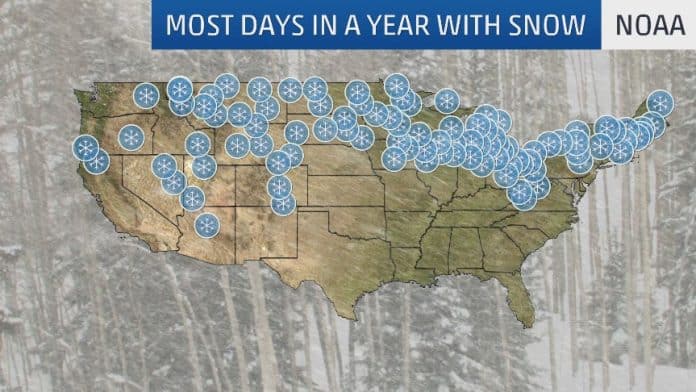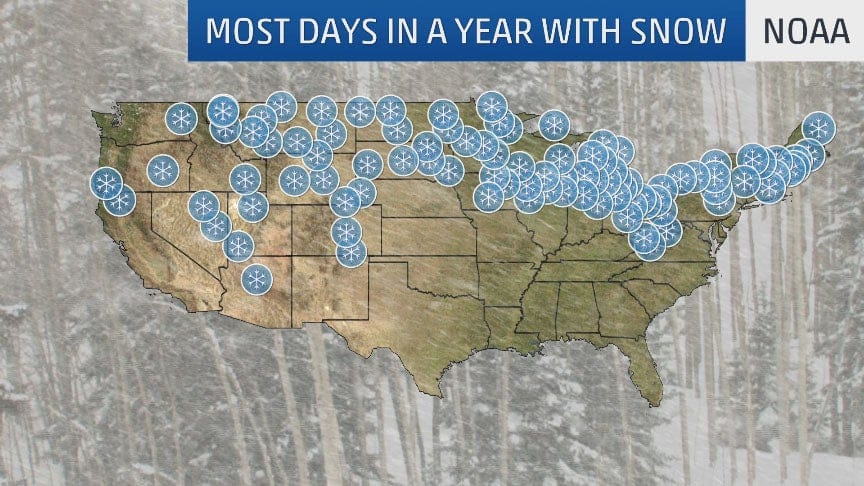Imagine waking up to a winter wonderland outside your window, with thick blankets of snow coating the entire city.
From the cozy comfort of your home, you may wonder, “Which city in the United States experiences the most snowfall?”
Look no further as we uncover the top ten snowiest cities in the US, where winter’s white embrace takes on a whole new meaning.
Let’s bundle up and journey through these picturesque winter wonderlands, where snowflakes dance in the sky and snowmen reign supreme.
1. Syracuse, New York
Syracuse, located in upstate New York, is renowned for its heavy snowfall. The average annual snowfall in Syracuse is about 124.1 inches, making it one of the snowiest cities in the US. The city experiences a long and snowy winter due to various factors contributing to high snowfall.
Average Annual Snowfall
Syracuse receives abundant snowfall each year, with an average of 124.1 inches. This substantial amount of snow can be attributed to its geographical location and the prevailing weather patterns in the region.
Factors Contributing to High Snowfall
The high snowfall in Syracuse can be attributed to its proximity to the Great Lakes, particularly Lake Ontario. These lakes significantly influence the weather patterns in the region and contribute to the regular and heavy snowfall. The phenomenon known as lake-effect snow occurs when cold air passes over the lakes’ relatively warm waters, causing intense snowfall downwind.
Historical Snowfall Records
Syracuse has a rich history of heavy snowfall, with numerous records of snowstorms and blizzards. One of Syracuse’s most significant snow events occurred in 1993 when the city received a staggering 162.2 inches of snow, earning it the nickname “The Blizzard of ’93.” The resilience and preparedness of the city’s residents during such extreme snowfall have become part of Syracuse’s identity.
Impact on Daily Life
The heavy snowfall in Syracuse has a significant impact on the daily lives of its residents. It affects transportation, often leading to road closures, delays, and challenging driving conditions. Schools and businesses may also temporarily shut down during severe snowstorms. However, the residents of Syracuse have adapted to these conditions and have developed effective strategies to deal with the snow.
Measures Taken to Deal with Snow
Syracuse has a well-coordinated snow removal system in place to combat heavy snowfall. The city employs snowplows, salt trucks, and other equipment to clear the roads and make them safe for travel. Additionally, residents are expected to shovel their sidewalks and clear their driveways to ensure safe passage for pedestrians.
Popular Winter Activities
Despite the challenges posed by heavy snowfall, Syracuse residents have embraced the winter season and the opportunities it brings. Winter sports such as skiing, snowboarding, and ice skating are popular activities in the area. The city has several well-maintained ski resorts, ice rinks, and outdoor parks where people can enjoy the snow. Syracuse also hosts events like the Syracuse Winterfest, attracting visitors from near and far to celebrate the winter season.
2. Rochester, New York
Rochester, another city in upstate New York, also experiences significant snowfall each year. Known for its cold and snowy winters, Rochester is a haven for winter enthusiasts.
Average Annual Snowfall
Rochester receives an average annual snowfall of about 94.4 inches. The city’s proximity to Lake Ontario and its susceptibility to lake-effect snow contribute to its high snowfall totals.
Factors Contributing to High Snowfall
Like Syracuse, Rochester is affected by lake-effect snow due to its location near Lake Ontario. The prevailing winds carry moisture from the lake, leading to increased snowfall in the region. With its hills and valleys, Rochester’s topography also contributes to snow accumulation.
Historical Snowfall Records
Rochester has a history of notable snowstorms and blizzards. In 1993, the city experienced the “Storm of the Century,” which brought about 32.3 inches of snow in just 24 hours. The resilience of Rochester residents during such extreme weather events showcases their ability to adapt and thrive in snowy conditions.
Impact on Daily Life
The heavy snowfall in Rochester affects daily life, including transportation, school closures, and business operations. Snowstorms often result in icy roads and reduced visibility, making driving hazardous. However, the city is well-prepared for these conditions, as snow removal crews work tirelessly to clear roads and ensure safety.
Measures Taken to Deal with Snow
Rochester employs a comprehensive snow removal plan to manage the heavy snowfall. The city uses plows, salt trucks, and snow blowers to clear the streets promptly. Additionally, residents are responsible for clearing their sidewalks and driveways to maintain safe walkways for pedestrians.
Popular Winter Activities
Winter in Rochester offers a plethora of activities for residents and visitors. The city boasts ski resorts, ice rinks, and cross-country skiing trails. Parks and outdoor spaces are transformed into winter wonderlands, attracting families and outdoor enthusiasts. Rochester’s Winterfest and other seasonal events provide opportunities to embrace the snowy season and enjoy festivities unique to this snow-covered city.
3. Buffalo, New York
Buffalo, New York, is notorious for its heavy snowfall, earning it the title of one of the snowiest cities in the US. Situated on the eastern shores of Lake Erie, Buffalo experiences significant snowstorms and lake-effect snow throughout the winter months.
Average Annual Snowfall
Buffalo receives an average of 93.6 inches of snowfall per year, making it one of the snowiest cities in the country. The lake-effect snow from Lake Erie contributes to the heavy snowfall totals in Buffalo.
Factors Contributing to High Snowfall
Buffalo’s location near Lake Erie exposes it to lake-effect snow, a weather phenomenon in which cold air masses pass over the warm waters of the lake, resulting in intense snowfall downwind. The city’s topography, including its proximity to the Great Lakes, further enhances the development and accumulation of snow.
Historical Snowfall Records
Buffalo has a history of record-breaking snowstorms. In 1977, the city experienced the infamous “Blizzard of ’77,” which brought about 100 inches of snow and created immense challenges for residents. Such extreme snow events have shaped Buffalo’s identity and resilience in the face of heavy snowfall.
Impact on Daily Life
The heavy snowfall in Buffalo significantly impacts daily life, affecting transportation, school closures, and overall mobility. The city has developed effective strategies to manage these conditions and has become adept at handling significant snowfall events. However, the snowscape also presents opportunities for winter enthusiasts and promotes a sense of camaraderie among Buffalo residents.
Measures Taken to Deal with Snow
Buffalo has a well-established snow removal system that tackles heavy snowfall efficiently. Snowplows, salt trucks, and other equipment are deployed to clear the roads promptly. The city’s residents also play an essential role in snow removal, as they are responsible for clearing their sidewalks and driveways.
Popular Winter Activities
Despite the challenges posed by heavy snowfall, Buffalo embraces its snowy winter season and offers numerous activities for residents and visitors. Skiing, snowboarding, and ice skating are popular pursuits, with several facilities catering to winter sports enthusiasts. The city’s winter festivals, such as the Labatt Blue Buffalo Pond Hockey Tournament, draw people together to celebrate the joys of winter and showcase Buffalo’s unique winter culture.
4. Erie, Pennsylvania
Erie, Pennsylvania, located on the shores of Lake Erie, experiences substantial snowfall, making it one of the snowiest cities in the US. The lake-effect snow originating from Lake Erie blankets the city and creates a winter wonderland for its residents.
Average Annual Snowfall
Erie receives an average annual snowfall of around 100.8 inches, making it one of the snowiest cities in Pennsylvania and the entire United States. The city’s location near Lake Erie exposes it to intense lake-effect snowfall.
Factors Contributing to High Snowfall
The primary factor contributing to Erie’s high snowfall is its proximity to Lake Erie. The lake-effect snow that occurs when cold air masses pass over the warm waters of the lake results in heavy snowfall in the region. The city’s topography, which includes hills and valleys, further enhances snow accumulation.
Historical Snowfall Records
Erie has a history of notable snowstorms and extreme snowfall events. In December 2017, the city experienced a record-breaking snowfall of 65.1 inches in just four days, earning it the title of the snowiest week in Erie’s history. These extraordinary snow events have shaped Erie’s identity and resilience in the face of heavy snowfall.
Impact on Daily Life
The heavy snowfall in Erie affects various aspects of daily life, such as transportation, school closures, and outdoor activities. Snowstorms often lead to hazardous road conditions and reduced visibility, making it challenging to travel. However, Erie residents have adapted to these conditions and have developed effective measures to cope with the snow.
Measures Taken to Deal with Snow
Erie has a well-coordinated snow removal system to manage the heavy snowfall. Snowplows, salt trucks, and other equipment are deployed to clear the roads promptly and ensure safe passage. Residents are responsible for clearing their sidewalks and driveways and keeping the city accessible during winter storms.
Popular Winter Activities
Despite the challenges posed by heavy snowfall, Erie embraces its winter season and offers a range of activities for residents and visitors. Winter sports such as skiing, snowboarding, and ice fishing are popular among those seeking outdoor adventures. Presque Isle State Park, located near Lake Erie, is a haven for winter enthusiasts, offering opportunities for cross-country skiing, snowshoeing, and snowmobiling. Erie’s Winterfest and other seasonal events provide opportunities to celebrate the snow and participate in festivities unique to this snow-covered city.
5. South Bend, Indiana
Nestled in northern Indiana, South Bend experiences significant snowfall throughout the winter months. The city’s winter wonderland and snowy landscapes attract residents and visitors alike.
Average Annual Snowfall
South Bend receives an average annual snowfall of approximately 79.9 inches, making it one of the snowiest cities in the United States. The city’s location in the Snow Belt region contributes to its heavy snowfall totals.
Factors Contributing to High Snowfall
South Bend’s high snowfall can be attributed to several factors, including its location in the Snow Belt. The Snow Belt refers to the regions characterized by heavy snowfall due to their proximity to the Great Lakes. South Bend’s position near Lake Michigan exposes it to lake-effect snow, resulting in increased snowfall.
Historical Snowfall Records
South Bend has a history of notable snowstorms and extreme winter weather events. In 2014, the city experienced a winter storm that brought about 18.3 inches of snow in just 24 hours, making it one of the most significant snowfalls in South Bend’s history. These winter events have shaped the city’s identity and the resilience of its residents.
Impact on Daily Life
The heavy snowfall in South Bend impacts daily life, including transportation, school closures, and outdoor activities. Snowstorms can make driving hazardous and cause delays or road closures. However, residents have learned to adapt to these conditions and have implemented measures to ensure safety and accessibility.
Measures Taken to Deal with Snow
South Bend has a comprehensive snow removal plan to manage heavy snowfall effectively. Snowplows, salt trucks, and other equipment are deployed to clear the roads promptly. The city’s snow removal crews work diligently to maintain safe passage and ensure that essential services can continue during winter storms.
Popular Winter Activities
Despite the challenges presented by heavy snowfall, South Bend residents embrace the winter season and engage in various winter activities. The city offers skiing, snowboarding, ice skating, and sledding opportunities. Local parks and outdoor spaces transform into winter wonderlands, attracting families and outdoor enthusiasts. South Bend’s Winterfest and other seasonal events allow the community to come together and celebrate the joys of winter.
6. Cleveland, Ohio
Cleveland, Ohio, experiences heavy snowfall during its winter season, creating a picturesque landscape and providing ample opportunities for winter fun. The city’s location by Lake Erie and its weather patterns contribute to its notable snowfall totals.
Average Annual Snowfall
Cleveland receives an average annual snowfall of about 69.1 inches, making it one of the snowiest cities in Ohio. The proximity to Lake Erie and its effects on local weather contribute to the substantial snowfall in the area.
Factors Contributing to High Snowfall
Cleveland’s high snowfall can be attributed to its location and lake-effect snow. The prevailing winds pick up moisture from Lake Erie, leading to increased snowfall in the region. Cold air masses passing over the lake result in heavy snowfall downwind, impacting Cleveland and its surrounding areas.
Historical Snowfall Records
Cleveland has a history of notable snowstorms, with snowfall records dating back decades. In January 1978, the city experienced a blizzard that brought about 22 inches of snow and caused significant disruptions. The ability of Cleveland residents to adapt and persevere during extreme snow events showcases their resilience in the face of heavy snowfall.
Impact on Daily Life
The heavy snowfall in Cleveland affects various aspects of daily life, including transportation, school closures, and outdoor activities. Snowstorms often lead to challenging driving conditions and delays. However, the city is well-prepared for snowfall events and has contingency plans to ensure that essential services can continue despite the weather challenges.
Measures Taken to Deal with Snow
Cleveland has a robust snow removal system to manage heavy snowfall effectively. Snowplows, salt trucks, and other equipment are deployed to clear the roads promptly. Additionally, residents are responsible for clearing their sidewalks and driveways to ensure safe passage for pedestrians.
Popular Winter Activities
Cleveland offers a wide range of winter activities for residents and visitors alike. Ice skating, skiing, and snowboarding are popular in the area, with several facilities catering to winter sports enthusiasts. The city’s parks and outdoor spaces transform into winter wonderlands, providing sledding, snowshoeing, and cross-country skiing opportunities. Cleveland’s Winterfest and other winter-themed events showcase the city’s vibrant culture and provide a platform for the community to celebrate the snowy season.
7. Duluth, Minnesota
Duluth, located on the western tip of Lake Superior, experiences heavy snowfall each year, making it one of the snowiest cities in Minnesota and the entire United States. The frigid temperatures and lake-effect snow contribute to Duluth’s winter climate.
Average Annual Snowfall
Duluth receives an average annual snowfall of approximately 81.4 inches, making it one of the snowiest cities in Minnesota. Its proximity to Lake Superior and the prevailing weather patterns contribute to the heavy snowfall in the area.
Factors Contributing to High Snowfall
Duluth’s high snowfall can be attributed to several factors, including its location near Lake Superior. The lake-effect snow that occurs when cold air masses pass over the lake’s relatively warm waters contributes to the region’s heavy snowfall. Duluth’s hilly terrain and position within the Snow Belt further enhance snow accumulation.
Historical Snowfall Records
Duluth has a history of notable snowstorms and extreme winter weather events. In 1996, the city experienced a winter storm that brought about 33.9 inches of snow, making it one of the most significant snowfalls in Duluth’s history. These winter events have shaped the city’s identity and the resilience of its residents.
Impact on Daily Life
The heavy snowfall in Duluth affects various aspects of daily life, including transportation, school closures, and outdoor activities. Snowstorms often lead to hazardous road conditions, reduced visibility, and delays. However, the city is prepared for winter weather and has implemented measures to ensure safety and accessibility.
Measures Taken to Deal with Snow
Duluth has a comprehensive snow removal plan to manage heavy snowfall efficiently. Snowplows, salt trucks, and other equipment are deployed to clear the roads promptly. The city’s snow removal crews work diligently to maintain safe passage and ensure that essential services can continue during winter storms.
Popular Winter Activities
Duluth’s heavy snowfall offers residents and visitors a wide range of winter activities. From skiing and snowboarding to snowshoeing and ice fishing, the city provides opportunities for outdoor enthusiasts to embrace the snowy season. Duluth’s famous festivals, such as the Bentleyville Tour of Lights, provide a magical winter experience for the community and attract visitors from near and far.
8. Flagstaff, Arizona
While not traditionally thought of as a snowy destination, Flagstaff, Arizona, experiences significant snowfall due to its high elevation and unique weather patterns. The city’s wintertime charm and snowy landscapes create an inviting atmosphere for residents and tourists.
Average Annual Snowfall
Flagstaff receives an average annual snowfall of approximately 101.8 inches, making it one of the snowiest cities in Arizona. The city’s location in the Coconino National Forest at an elevation of 7,000 feet contributes to its heavy snowfall.
Factors Contributing to High Snowfall
Flagstaff’s high snowfall can be attributed to its elevation and proximity to the San Francisco Peaks, the highest mountain range in Arizona. The city’s unique weather patterns, combined with moisture brought by storms from the Pacific, result in heavy snowfall in the region.
Historical Snowfall Records
Flagstaff has a history of notable snowstorms and extreme winter weather events. In 1967, the city experienced a substantial snowfall that brought about 84 inches of snow in just a few days. This record-breaking snowfall showcases the extremes that Flagstaff’s weather can reach.
Impact on Daily Life
The heavy snowfall in Flagstaff impacts various aspects of daily life, including transportation, school closures, and outdoor activities. Snowstorms can make driving hazardous and may lead to road closures or delays. However, Flagstaff is accustomed to snowfall and has measures in place to ensure that essential services can continue despite the weather conditions.
Measures Taken to Deal with Snow
Flagstaff has a comprehensive snow removal plan to manage heavy snowfall efficiently. Snowplows and other equipment are used to clear the roads promptly. Additionally, residents and businesses are responsible for shoveling their sidewalks and driveways to ensure safe passage for pedestrians.
Popular Winter Activities
Flagstaff’s heavy snowfall offers a range of winter activities for residents and visitors. The city is home to the Arizona Snowbowl, a popular ski resort providing skiing, snowboarding, and tubing opportunities. The surrounding Coconino National Forest offers trails for snowshoeing and cross-country skiing. Flagstaff’s Winter Wonderland Event, held annually, showcases the city’s winter traditions and offers a festive experience for all.
9. Grand Rapids, Michigan
Grand Rapids, located in western Michigan, experiences significant snowfall during the winter months. The city’s snowy landscapes create a picturesque environment and provide ample opportunities for winter activities.
Average Annual Snowfall
Grand Rapids receives an average annual snowfall of approximately 75.1 inches, making it one of the snowiest cities in Michigan. The city’s location in the Snow Belt region and its proximity to Lake Michigan contribute to its heavy snowfall.
Factors Contributing to High Snowfall
Grand Rapids experiences heavy snowfall due to its location in the Snow Belt and proximity to Lake Michigan. The lake-effect snow that occurs when cold air masses pass over the warm waters of the lake results in intense snowfall in the region, including Grand Rapids.
Historical Snowfall Records
Grand Rapids has a history of notable snowstorms and significant winter weather events. In 2014, the city experienced a winter storm that brought about 16.2 inches of snow, making it one of the most significant snowfalls in Grand Rapids history. These winter events have shaped the city’s identity and the resilience of its residents.
Impact on Daily Life
The heavy snowfall in Grand Rapids impacts daily life, including transportation, school closures, and outdoor activities. Snowstorms can lead to challenging driving conditions and delays. However, Grand Rapids is accustomed to snowfall and has developed effective strategies to handle these conditions.
Measures Taken to Deal with Snow
Grand Rapids has a robust snow removal system to manage heavy snowfall. Snowplows, salt trucks, and other equipment are deployed to clear the roads promptly. Additionally, residents are responsible for clearing their sidewalks and driveways to maintain safe walkways for pedestrians.
Popular Winter Activities
Despite the challenges of heavy snowfall, Grand Rapids residents embrace the winter season and engage in various activities. Skiing, snowboarding, and ice skating are popular winter sports in the area, with several facilities catering to enthusiasts. Grand Rapids’ WinterWest festival and other seasonal events provide opportunities for the community to come together and celebrate winter through art, music, and outdoor activities.
10. Anchorage, Alaska
As the largest city in Alaska, Anchorage experiences significant snowfall and is well-known for its winter wonderland and snowy landscapes. The city’s location and unique climate contribute to its notable snowfall totals.
Average Annual Snowfall
Anchorage receives an average annual snowfall of approximately 74.5 inches, making it one of the snowiest cities in Alaska and the United States. The city’s location in a subarctic climate zone and its geographical features result in heavy snowfall.
Factors Contributing to High Snowfall
Anchorage’s high snowfall can be attributed to its high latitude and maritime climate. The city’s proximity to the Chugach Mountains and the Gulf of Alaska exposes it to moisture-laden weather systems, resulting in significant snowfall during the winter months.
Historical Snowfall Records
Anchorage has a history of notable snowstorms and extreme winter weather events. In 2012, the city experienced a winter storm that brought about 28.1 inches of snow, making it one of the most significant snowfalls in Anchorage’s history. These winter events have shaped the city’s identity and the resilience of its residents.
Impact on Daily Life
The heavy snowfall in Anchorage affects daily life, including transportation, school closures, and outdoor activities. Snowstorms can make driving challenging and may lead to delays or road closures. However, the city is accustomed to snowfall and has measures in place to ensure the safety and accessibility of essential services.
Measures Taken to Deal with Snow
Anchorage has a well-established snow removal system to manage heavy snowfall efficiently. Snowplows, salt trucks, and other equipment are deployed to clear the roads promptly. The city’s residents also play an essential role in snow removal, as they are responsible for clearing their sidewalks and driveways.
Popular Winter Activities
Anchorage offers a wide range of winter activities for residents and visitors. Skiing, snowboarding, and snowshoeing are popular pursuits, with numerous ski resorts and trails available. The city’s annual Fur Rondy festival and other winter events celebrate Anchorage’s snowy season and provide opportunities for the community to come together and embrace the joys of winter.











































